Commonly used landscape flowers
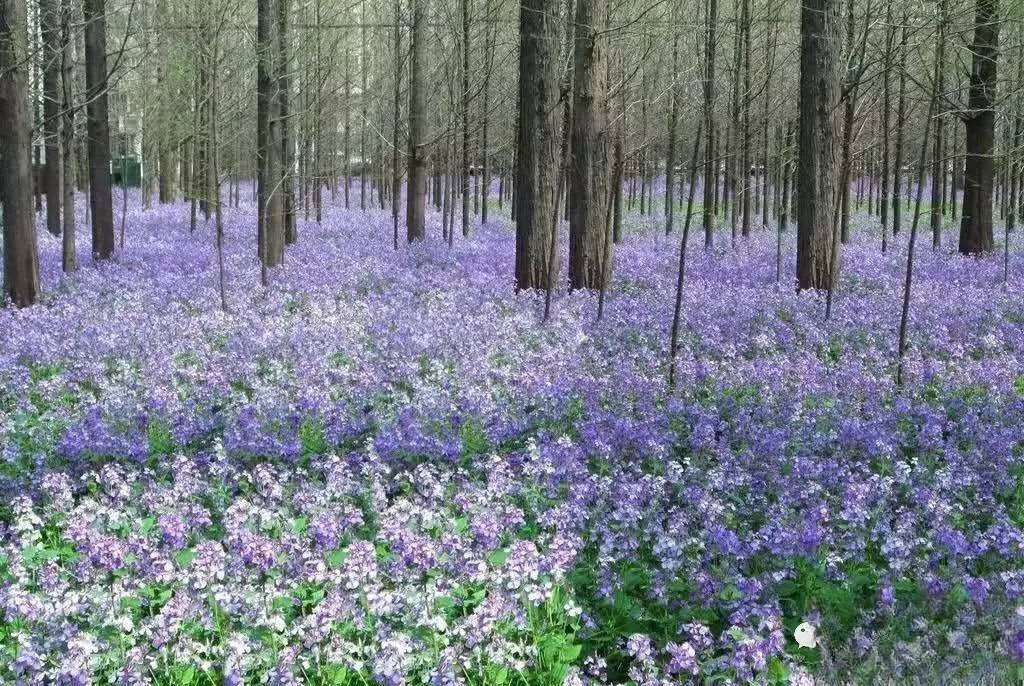
We usually call landscape flowers "wild flowers", but they are not wild flowers in the true sense, but are relative to conventional horticultural flowers. One is full seed propagation, and the other is produced and cultivated by professional breeding companies at home and abroad. Although their quality is not as good as horticultural flower seeds, they have obvious advantages: ① Mainly perennial; ② A wide variety of species; ③ Strong resistance and wide adaptability; ④ Low planting cost and good effect.
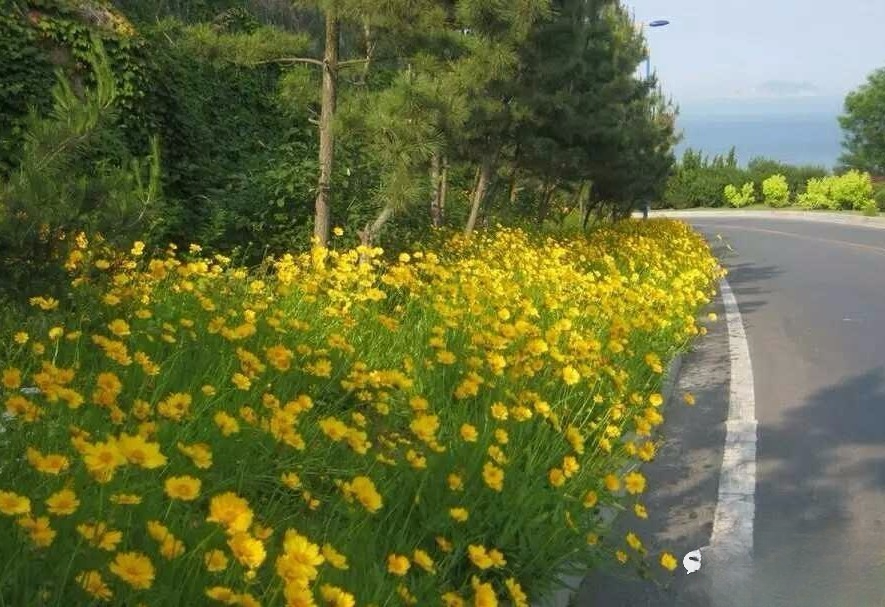
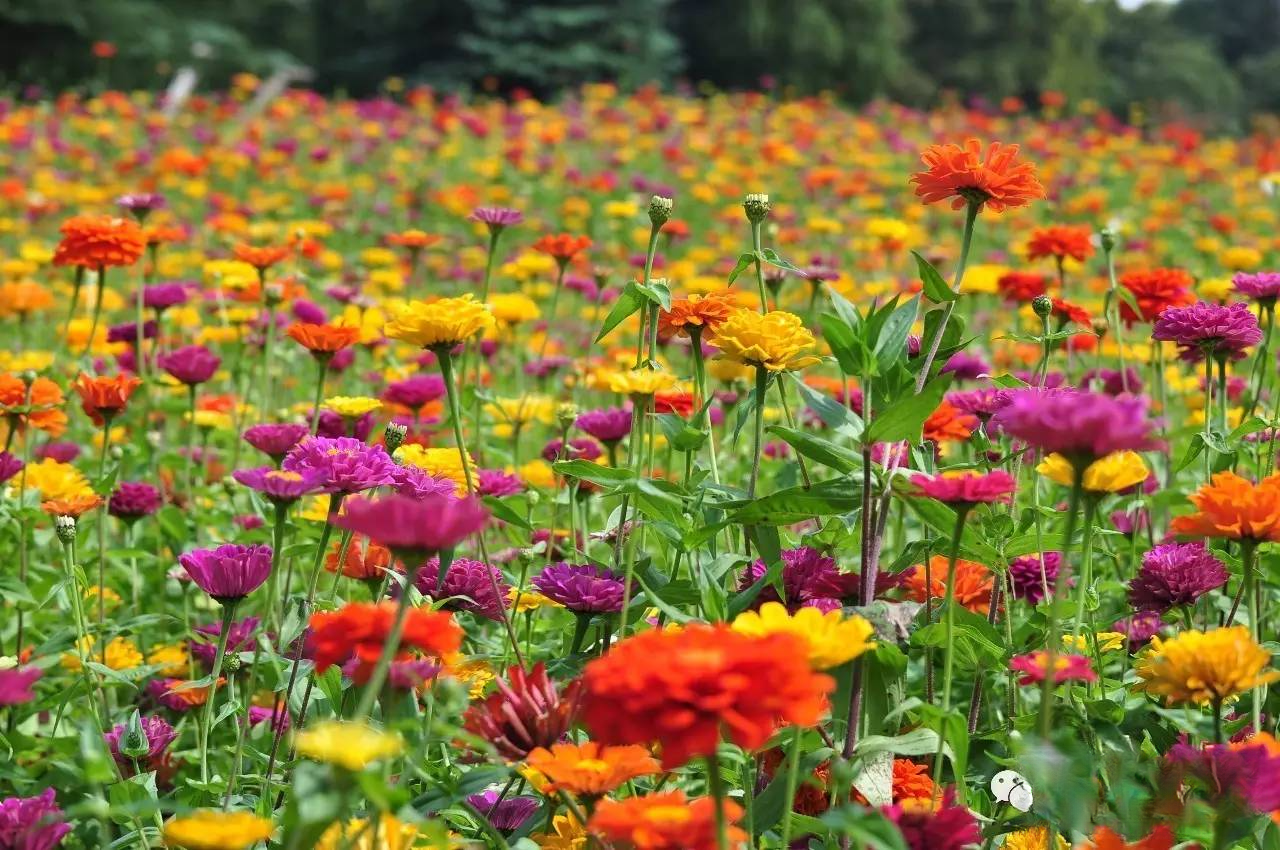
1. Half Lotus
Chinese name | Flowering period | Particles/g | type | color | Latin name | high |
Scutellaria barbata | Summer-Autumn | 10000 | First Year | Yellow/Pink/Red/Purple/White | Portulaca grandiflora | 10-20 |
Because its leaves resemble pine needles and its flowers resemble peonies, the half-branched lotus is also called "pine needle peony". The flowers are large and colorful, and its fleshy leaves are round and stick-shaped. The flowers are large and the leaves are few, so it is drought-resistant. Half-branched lotus likes strong light and its flowers will close at night or on cloudy days. As a super dwarf species, half-branched lotus has good adaptability to the environment, making it one of our highly recommended choices.
Therefore, its sowing time is suitable from spring to autumn. Scutellaria barbata likes strong light and is very drought-resistant. It has tenacious vitality and is commonly known as "immortal". These ultra-low-maintenance characteristics make it have obvious advantages in large-scale landscape greening with relatively poor planting and management conditions.
The half-branch lotus blooms in the sun and closes in the morning, evening and cloudy days, so it is called "sun flower" and "noon flower". The half-branch lotus has rich colors including white, yellow, red and purple. When sowing, please note that the seeds are small and should not be covered with soil. Just press the bed directly.
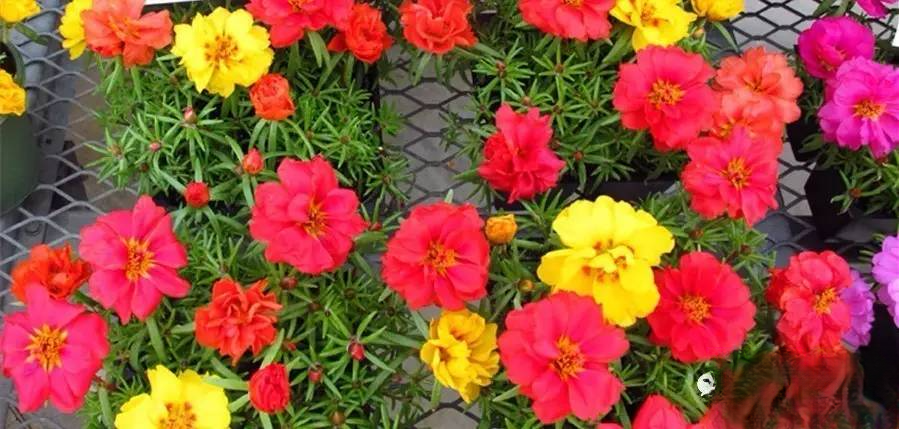
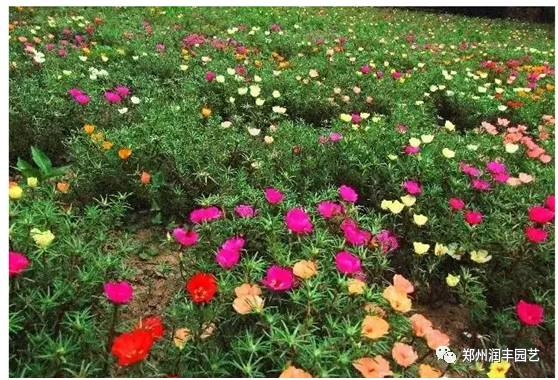
2. Sulfur chrysanthemum
Chinese name | Flowering period | Particles/g | type | color | Latin name | high |
Sulfur chrysanthemum | Summer-Autumn | 110 | First Year | Orange | Cosmos sulphureus | High pole 60-100, low pole 40-60 |
Sulfur daisy is brightly colored and highly adaptable, with a striking orange-red color and superb resistance to barrenness. It can be used in large landscapes under strong sunlight, and can also be paired with other plants to form a very outstanding landscape flower combination. Experiments have shown that it can still grow well and bloom under the shade of trees with a light intensity of 1500-2000 lux.
Due to its ease of planting, rapid flowering and relatively long flowering period, Sulfur chrysanthemum is also one of the commonly recommended fast-growing and excellent ground cover landscape flowers. It can be sown from late spring to early autumn and obtain a lush landscape effect.
Sulfur chrysanthemum is also often mixed with dwarf cosmos (common cosmos varieties are taller than Sulfur chrysanthemum, so they are not suitable for mixed planting).
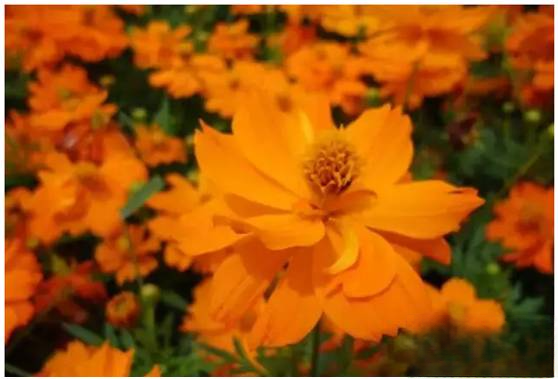
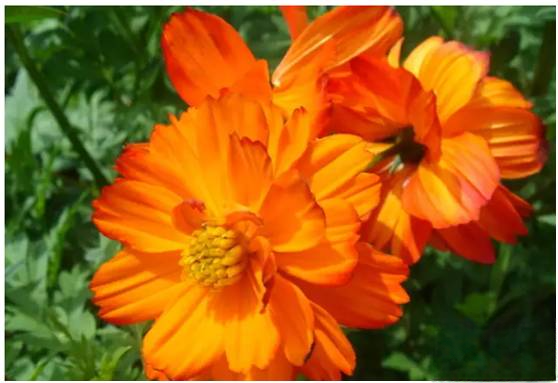
3. Baby's breath
Chinese name | Flowering period | Particles/g | type | color | Latin name | high |
Baby's breath | summer | 800 | First and second year students | Pink | Gypsophila elegans | 50-80 |
In early summer, countless white or pink buds gather on the branches. The white and slightly fragrant flowers form a spectacular cluster of flowers, like thousands of shining stars hanging in the sky. From a distance, it looks like morning clouds and evening sunsets, so it is also called "Sunset Grass". Depending on the use environment, you can choose from three types: large white flowers, small white flowers, and large pink flowers. Due to the Chinese people's habit of choosing colors, pink baby's breath is more popular when used for large-area landscapes.
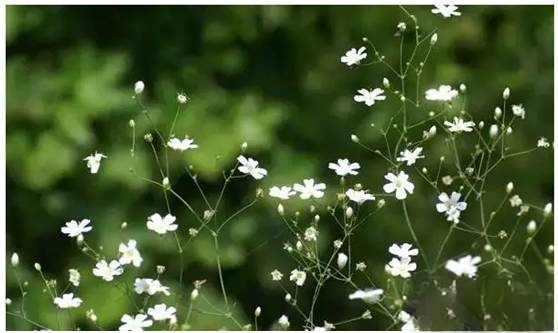
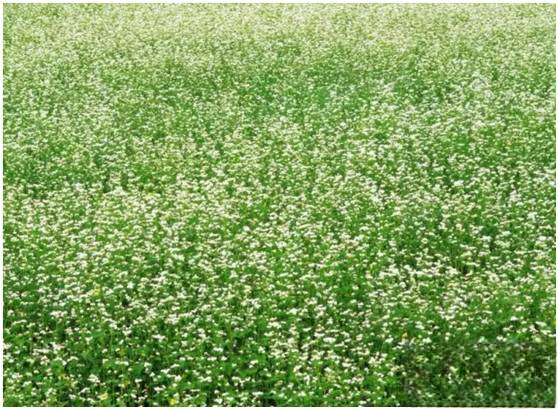
4. Cornflower
Chinese name | Flowering period | Particles/g | type | color | Latin name | high |
Cornflower | Summer-Autumn | 220 | First and second year students | Blue/Red/Yellow/Purple | Centaurea cyanus | High pole 50-70, low pole 30-50 |
Cornflower is one of the most commonly used landscape flowers. It has nearly ten kinds of colors, which are very rich. The clustered flowers are in the shape of small balls, and the flower shape is unique. Different varieties have different growth heights.
One variety can create a rich and colorful landscape, so it has become the favorite of landscape designers. It is a good material for landscape planting, potted plants and cut flowers. It can be matched with other grass flowers to arrange flower beds and flower borders, or it can be planted in pieces. Tall varieties can also be used as cut flowers.
Cornflowers are native to Europe. On the country roads and wheat fields in Europe, you can see the small and cute figures of cornflowers, which exude a faint fragrance. Especially in Germany, which is located in Central Europe, there are traces of cornflowers on hillsides, fields, in front of and behind houses, on roadsides and by the water.
Every summer is the season for cornflowers to bloom. The head inflorescences of medium size grow on the top of the slender stems, like beautiful girls. Cornflower is also one of the classic varieties commonly used in combinations.

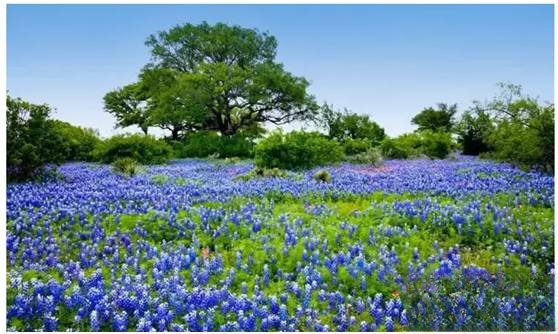
5. Heavenly chrysanthemum
Chinese name | Flowering period | Particles/g | type | color | Latin name | high |
Heavenly chrysanthemum | summer | 350 | perennial | Yellow and red | Gaillardia aristata | High pole 50-70, low pole 20-40 |
The red and yellow color combination of Gaillardia is very consistent with the Chinese concept of "joy and auspiciousness", and its growth height is relatively low, so designers often use Gaillardia to arrange large areas of landscape ground cover to create a festive atmosphere. It
is more cold-resistant than ordinary varieties. In late autumn, when other flower species have already fallen, its wonderful figure is still on the landscape stage. Therefore, Gaillardia is a prominent representative of perennial autumn flowers.
Gaillardia is native to North America and is highly resistant to drought and heat, so its flowering period is very long (it can be planted from spring to autumn) and it can adapt to a wide range of areas.
It is sown in spring, autumn and winter (in the south), and spring sowing is the best. It can reproduce by self-seeding and is strong in nature. Therefore, Gaillardia is a good herbaceous flower for greening, beautification and sand fixation in sandy land, and its cultivation and management are simple.
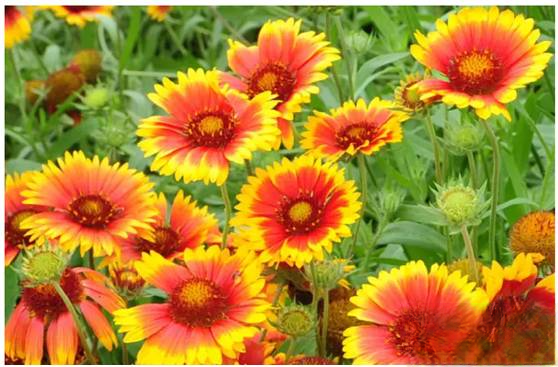
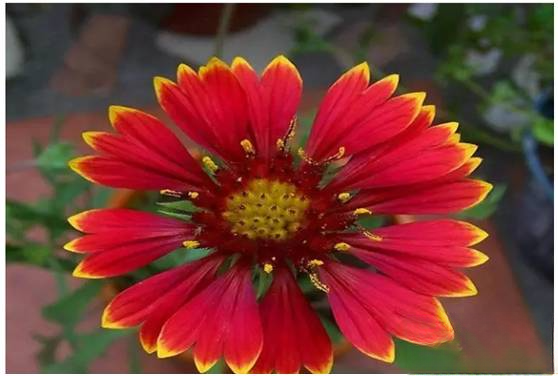
6. Lavender
Chinese name | Flowering period | Particles/g | type | color | Latin name | high |
Lavender | Summer-Autumn | 1000 | perennial | Blue Purple | Lavandula angustifolia | 40-60 |
Lavender is a landscape flower and spice plant with a long history. It was the favorite bath additive of the ancient Greeks and Romans. The English name Lavender comes from the Latin "Larare", which means "washing". The fragrance acts on the brain and changes brain waves. Lavender can stimulate the alpha waves of the human brain, which can make people calm and stable. In its place of origin, Provence, France, lavender has become the pride of the locals. Lavender fields are wild. In the mid-19th century, people began to pick wild lavender in an organized manner, and large-scale cultivation began in the 1920s.
Lavender cultivation requires certain expertise, and usually gibberellins are used to break dormancy in order to increase the germination rate.
Lavender is not only a typical vanilla flower plant, but also carries a lot of cultural connotations due to its long history of cultivation, becoming a representative of the romantic and romantic French style. In the suburbs of Beijing, people who love the romantic French style have specially established a lavender manor, which has now become a paradise for tourists and photography enthusiasts.
Lavandula vera (English Lavender) is a narrow-leaved lavender. Compared with French Lavender, it has a stronger fragrance and is the most suitable lavender variety for essential oil extraction.
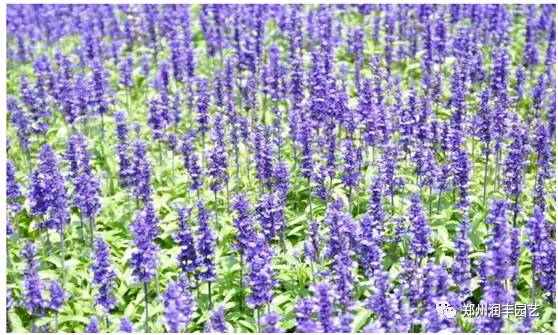
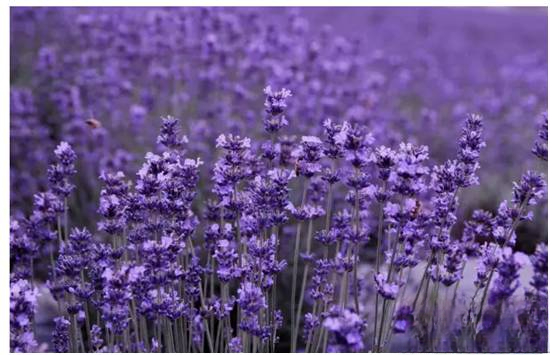
7. Poppy
Chinese name | Flowering period | Particles/g | type | color | Latin name | high |
poppy | Spring-Summer | 11500 | First and second year students | Pink/white/purple/red | Papaver rhoeas | 40-80 |
When the poppy flower is not in bloom, the egg-shaped buds are covered with two green sepals with white edges, hanging alone on the slender upright pedicels, very much like a girl with her head down in deep thought.
When it blooms, the bent stem stands upright, and the four thin petals on the upward flower are as thin as satin and as smooth as silk. The light corolla looks like red clouds and colorful silk. It seems to sway even in the wind, and seems to fly when the wind blows.
The beauty of corn poppy is both simple and elegant, and the two are harmoniously unified in one. Its appearance and posture have the charm of beauties in Chinese classical art, and it can be called a masterpiece among flowers and plants. Uses: ground cover, rock garden, flower border, combination, potted plant, flower bed.
The flower of Poppy is smaller than that of Icelandic Poppy, but because it is an annual species, it blooms quickly and has strong self-seeding ability. It is a better choice when the landscape effect needs to be formed within the same year.
Poppies are often mixed with highly similar species such as aster, cornflower, and cosmos. Its red color is matched with the orange of aster, the red and blue of cornflower, and the yellow and red of cosmos, creating a very colorful effect.
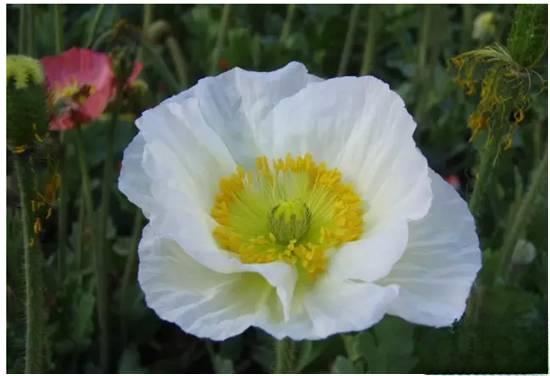
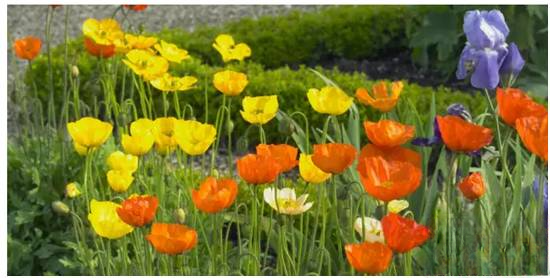
8. Zinnia
| Chinese name | Flowering period | Particles/g | type | color | Latin name | high |
| Zinnia | Summer-Autumn | 120 | First Year | Yellow/Pink/Red/Purple/Orange | Zinnia elegans | High pole 50-80, low pole 30-50 |
Zinnias are native to the southwestern United States, Mexico, and South America, so they are resistant to barrenness, drought, and are strong. They are naturally rugged and bold in the American style, with large flowers and bright colors. Because of their hard stems, the plants are upright and not easy to fall over. Zinnias grow in uniform heights, and when planted in large areas, they can form a majestic landscape effect. Because of their bright colors, butterflies and bees often dance on them.
Large-flowered zinnias have full flowers (see picture) and a wide variety of colors. Small-flowered zinnias are dense and lush, with more flowers. Therefore, they can provide landscape effects with different styles. Zinnias are also one of the species we recommend for you that are very easy to grow and very easy to produce results.
Zinnia is a relatively short-day plant. When the daylight is longer than 14 hours, flowering will be delayed, and it will take about 70 days from sowing to flowering. At this time, the number of ligulate flowers will increase significantly; when the daylight is shorter than 12 hours, it can bloom earlier, and the time from sowing to flowering will be shortened to about 60 days. Therefore, experienced growers can control the flowering period by adjusting the sowing period and pinching time.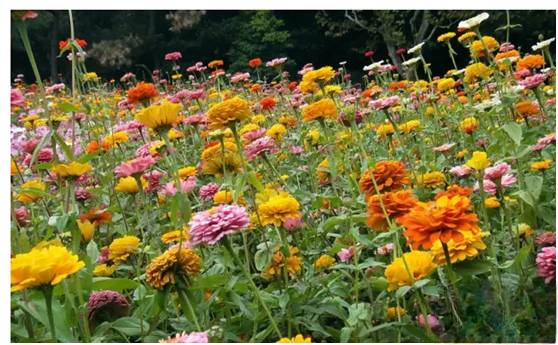

9. Cosmos
| Chinese name | Flowering period | Particles/g | type | color | Latin name | high |
| Cosmos | Summer-Autumn | 120 | First Year | Pink/white/red | Cosmos bipinnatus | High pole 50-100, low pole 30-50 |
The excellent drought resistance, cold resistance and barrenness resistance of Cosmos make it the first choice for various landscape decoration materials that lack maintenance environment. It likes light and can tolerate semi-shade and high temperature. It grows rapidly, so you can often see its swaying figure on the roadside and slopes. Its leaves and branches are slender, so whether it is sown alone or combined with other wild flower varieties, it can form a beautiful landscape.
Wild species are mostly mixed colors, while commercially produced seeds have a variety of color-separated flower shapes to choose from.
In addition to the richness of color selection, commercially produced seeds are more uniform in plant shape, suitable for arranging flower mirrors, planting in patches on the edge of the grass, in the bushes, around and on the roadside as background materials, which is quite wild.
In addition to growing quickly, the outstanding self-seeding ability of cosmos is also an important reason for us to recommend it, which allows you to greatly save the labor of sowing while maintaining the landscape effect.


10. Mirabilis jalapa
| Chinese | Flowering period | Particles/g | type | color | Latin name | high |
| Mirabilis jalapa | Summer-Autumn | 12 | First and second year students | Yellow/Pink/Red/White | Mirabilis jalapa | 50-90 |
Mirabilis jalapa is a real native plant. If you are not familiar with the name "Mirabilis jalapa", you must have some impression of "landmine flower".
Its petals are light and elegant, and when in full bloom, they are translucent like gauze, with rich colors. It is one of the commonly used landscape greening materials. In the southern region, the underground part can safely overwinter and become a perennial grass flower, and continue to sprout and grow new plants in the spring of the following year. The flowers of Mirabilis jalapa open in the evening and early morning, and close under strong light. It grows and blooms well if there is sparse shade in summer. Mirabilis jalapa can reproduce by self-seeding.
Commercially produced jasmine seeds come in a variety of colors for you to choose from, including colorful types, passionate red, romantic yellow, and elegant white, all of which can help landscape designers use color more easily during construction.


11. Calendula
| Chinese name | Flowering period | Particles/g | type | color | Latin name | high |
| Calendula | Summer-Autumn | 120 | First Year | orange color | Marigold officinalis | 40-60 |
Calendula is native to southern Europe and the Mediterranean coast. It is said that the ancient Romans saw that the calendula flower bloomed on the first day of the month, so they named it after "Calends" (the first day of the Roman calendar). It has good adaptability and has become a widely distributed landscape flower. When the flower blooms, it looks like a golden plate, so it is named calendula.
It has large flowers, with one or more overlapping ligulate flowers in golden or orange colors. The flowers are bright yellow and the leaves are emerald green, which is very eye-catching.
Uses: flower beds, flower borders, potted plants, ground covers, general greening, and combinations.
Due to its relatively low height, marigold is particularly suitable for landscape foreground matching or large-scale planting. At the same time, the bright yellow-orange color is often matched with red varieties of the same height. It has become one of the commonly used varieties that Chinese designers particularly like to set off the festive atmosphere.


12. Icelandic Poppy
| Chinese name | Flowering period | Particles/g | type | color | Latin name | high |
| poppy | Spring-Summer | 11500 | First and second year students | Pink/white/purple/red | Papaver rhoeas | 40-80 |
Icelandic poppies are the representative of North American style landscape flowers. They have slender stems and large flowers, much larger than ordinary poppies. They have a unique plant shape and bright colors. Their seeds have a certain ability to self-propagate, so when planted in large areas, they can form a very spectacular sea of flowers that can last from spring to summer.
It is often used for single sowing or mixed sowing with other poppy species to form a beautiful poppy combination. It can be sown in spring or autumn, but the plants sown in autumn are more robust and are better for planting in patches.
The bright colors, low height and long flowering period of the Icelandic poppy make it a popular flower variety, and it is also one of the varieties we highly recommend.

13. Purple Echinacea
Echinacea purple is native to the central United States and is a perennial herb . The center of the flower head is black-purple, and the ligulate flowers on the edge of the flower head are rose purple. The flowering period is summer and autumn. The cultivated varieties include large-flowered varieties, red-flowered varieties, white-flowered orange-hearted varieties, and white-flowered green-hearted varieties. It is cold-resistant and heat-resistant, and grows robustly. It can generally be propagated by sowing . Cultivated varieties must be propagated by division , or root cuttings .
Echinacea purpurea, also known as purple coneflower, is a perennial herbaceous plant of the Asteraceae family . It is native to North America and grows in sunny and dry places, and has a certain degree of drought resistance.
Purple echinacea blooms without hesitation in the hot summer season. It develops calmly and passionately, and its petals are very textured. Touch the hard head of purple echinacea. When it is in bud, its inflorescence is flat; when it blooms, it bulges high, like a bulging pine cone; even if the petals wither, the inflorescence remains on the branch, and it looks beautiful without being removed; it makes people feel optimistic, positive, and sunny.


4. Sage
Sage has gray-green leaves and blue to purple flowers. Sage is native to southern Europe and the Mediterranean coast. Sage has many different uses and effects, and some plants of the same genus have the same effects. It is often cultivated as a kitchen herb or medicinal herb. It is sometimes called garden sage, kitchen sage, and Dalmatian sage.
The corolla of sage is light pink, light purple, light blue to white, about 12 mm long, densely covered with long soft hairs on the outside, and with an oblique sparse soft hair ring 2.5-4 mm from the base on the inside. The corolla tube is straight, tubular, about 9 mm long, protruding outward, 2 mm wide at the base, gradually widening upward, and up to 3.5 mm wide at the throat. The corolla is bilipped, the upper lip is elliptical or oval, 2.5 mm long, 2 mm wide, slightly emarginate at the apex, the lower lip is 3 mm long, 4 mm wide, and 3-lobed. The middle lobe is larger, inverted heart-shaped, with small round teeth on the edge, and the side lobes are oval and smaller.


15. February orchid
February orchid, a genus of the genus Zhugelan in the family Cruciferae, is an annual or biennial herb. It is called February orchid because it begins to bloom blue-purple flowers around the second month of the lunar calendar. It grows in plains, mountains, roadsides, and fields. It has low requirements for soil and light conditions, is cold-resistant and drought-resistant, and has strong vitality. Legend has it that Zhuge Liang picked young shoots as vegetables when he led his army to war, hence the name.
It is cold-resistant and evergreen in winter. It is shade-tolerant and can be used as ground cover. It has good covering effect. Its leaves are lush and green, which makes people like it. It has strong adaptability. It can grow from Northeast China and North China to East China and Central China. In case of heavy frost and snow in winter, some leaves will be frozen, but they can still sprout new leaves, bloom and bear fruit in early spring. It is not demanding on soil. Purple flowers bloom from bottom to top, and bloom continuously from February to May and June. Especially when planted in groups, it looks like a blue-purple ocean. If planted by the river or seawall, the green leaves, flowers, sea water and blue sky are intertwined, which is very spectacular.

16. Maidenhair
The capitula is solitary, 3.5-4 cm in diameter, with a peduncle 5-6.5 cm long and slightly thickened at the apex; the involucre is 1.5 cm long, 0.7 cm wide, oblong, with sharp teeth at the upper end and glandular dots; the ligulate flowers are golden yellow or orange with red spots; the ligules are nearly round, 8-10 mm long, 6-7 mm wide, and slightly concave at the apex; the corolla of the tubular flowers is yellow, 10-14 mm long, the same length as the pappus, and has 5 teeth.
Achenes are linear, narrowed at the base, 8-12 mm long, black, pubescent, with scaly pappus , 1-2 of which are long awn-shaped, and 2-3 are short and blunt. Flowering period is July-September.
The peacock grass originally had a common name called "sunflower". Later, it was "taken away" by the sunflower. Its flowers have the habit of blooming at sunrise and closing at sunset, and they grow in a phototropic way. Therefore, its flower language is "clear weather", which is extended to "hearty and lively". Anyone born under the blessing of this flower will never be sloppy!


17. Large-flowered Lysimachia
The large-flowered campion is a plant of the Caryophyllaceae family and the campion genus, native to Northeast China and North China. It can be used as an ornamental plant. It is a perennial herb. The whole plant is covered with relatively soft hairs. The stem is erect, single and slightly branched at the top. There are 5 petals, deep bright red, with two deep lobes at the tip.
Perennial herb. The whole plant is covered with relatively soft hairs. The stem is erect, single and slightly branched at the top. There are 5 petals, deep red, with 2 deep lobes at the tip.
Grown under forests, in shrubs at the edge of forests. Features: Perennial herb. The whole plant is covered with long soft hairs. Leaves are opposite, sessile, and ovate-oblong or ovate-lanceolate. Flowers: Cymes, flowers are deep red, petals have two deep lobes at the tip, and the top is slightly serrated. Flowering period is June to September.


18. Rudbeckia
Perennial herb , 50-200 cm high. The upper part of the stem is branched, glabrous or slightly short and rough hairy. The leaves are alternate, glabrous or sparsely hairy. The lower leaves have petioles, undivided or pinnately 5-7 deeply lobed, the lobes are oblong-lanceolate, pointed at the apex, and the margins are unequally sparsely serrated or shallowly lobed; the middle leaves are 3-5 deeply lobed, the upper leaves are undivided, ovate, pointed at the apex, entire or with a few coarse teeth, and the back margins are short and rough hairy. The head inflorescence is solitary at the end of the branch, with a long peduncle, 7-12 cm in diameter. The involucre is hemispherical; the involucral bracts are 2 layers, oblong, 7-10 mm long, pointed at the top, slightly curved, and short hairy. The receptacle is spherical; the apex of the receptacle is truncated, hairy, and the same length as the achene. The ligulate flowers are golden yellow; the ligules are oblanceolate, about twice as long as the involucral bracts, with 2 short teeth at the apex; the tubular flowers are yellow or yellow-green. Achenes are glabrous, flattened, slightly 4-sided, about 5-6 mm long, with a small crown with 4 teeth at the top. Flowering period is July-October.
It likes a well-ventilated and sunny environment. It is not very sensitive to sunlight . It has strong adaptability.
It is cold-resistant and drought-resistant. It is not very demanding on soil, but it avoids waterlogging. It grows best in well-drained, loose sandy soil. Although it is a herbaceous plant, it has the characteristics of a woody plant. Its stems are hard and not easy to fall over. It also has the characteristics of disease resistance and insect resistance. Therefore, it is very easy to cultivate. At the same time, it is not very sensitive to sunlight. Whether it is cultivated in a sunny area or in an environment with weak sunlight, it will not affect the bright effect of the flowers .


>>>> Sowing in frost-free areas
If you are in an area with no frost or a very short frost period, you can sow at any time as long as you avoid the hottest season. Of course, it is best to sow before the rainy season arrives, and the temperature should not be too high after the seedlings grow out. Therefore, autumn sowing is a good choice.
>>>> Sowing in areas with a short frost-free period
Both spring and autumn sowing can be chosen, and each has its own advantages and disadvantages.
Autumn sowing
It is obvious that "nature sows in the fall". In nature, wildflowers usually bloom in the summer and set seeds in the fall, and the seeds fall directly to the ground and "sow". Of course, the number of seeds that naturally fall to the ground and reproduce is quite large, but in the pure wild state, anything can happen - seeds fall on rocks or other crops and never touch the soil. This is the price of natural reproduction, and a large number of seeds are actually lost. For example, Rudbeckia, it blooms in midsummer and starts to set seeds in late summer. If the temperature is right, these seeds can germinate in the season. If the climate is dry and conditions are not suitable, they will overwinter in the open until they germinate next year.
Advantages of autumn sowing: Early flowering
The biggest advantage of autumn seeding, especially in cold regions, is that it blooms early, usually germinating and blooming about two weeks earlier than spring seeding. This characteristic is similar to lawn seeds - autumn-sown lawns mature faster than spring-sown lawns.
The plot of land you choose will also affect when you plant. If it is a flat plot of land, you can plant at any time. If it is a sloping plot of land, it is best to plant in spring. Seeds planted in the fall need to spend late fall and all winter in the soil, so they are more likely to be washed away.
If you decide to plant in the fall, it's best to wait until after the first frost to ensure the seeds don't germinate before the soil freezes.
Advantage 2: More time for autumn sowing
Gardeners have more time to sow in the fall. This is reflected in two aspects. First, the weather in spring is complex and changeable, while the weather in autumn is much better. Sowing will not be delayed by rain, and there is no time limit. The seeds must be sown at a certain time. Second, compared with the busy spring, gardeners have more time to work in the fall. So when sowing in the fall, you only need to choose a good site, prepare it, and then sow before the soil freezes.
Advantage 3: Weed control is easier
Fall sowing is done after the growing season ends, when weed seeds go dormant.
Weeds are dormant, which is very beneficial for sowing. For example, if you prepare the land on a weekend and do not sow until the next weekend, it is feasible in autumn, but not in spring. Obviously, the dormant weed seeds buy you plenty of time. In spring, you must prepare the land and sow on the same day, otherwise wildflower seeds will be completely at a disadvantage in competing with weed seeds.
Of course, everything has two sides. One disadvantage of autumn sowing is that you don't know how many weed seeds there are in the soil when you sow. Of course, autumn sowing at least ensures that flower seeds and weed seeds are in the same competitive position. In spring sowing, weed seeds that have experienced the entire winter have a clear competitive advantage.
Spring sowing
Most wildflower combinations are sown in spring, simply because that is the season people tend to sow. When sowing in spring, timing is important. Generally, you should wait until the threat of frost has passed. But there are other considerations.
When sowing in spring, it is best to sow on the same day after preparing the land, at least not until the next day. It is even more unacceptable to prepare the land this weekend and sow next weekend. The reason is that when you turn the land, you provide weed seeds with an opportunity to grow rapidly. If you do not sow in time, flower seeds will be at a significant disadvantage in the competition with weed seeds.
* about Us *
Zhengzhou Runfeng Horticulture Company is a professional company engaged in flowers and landscaping supplies. The company adheres to the business tenet of honesty, trustworthiness and excellence, and is committed to promoting the best quality and latest trendy horticultural products to the majority of garden workers.
Scan and follow us!